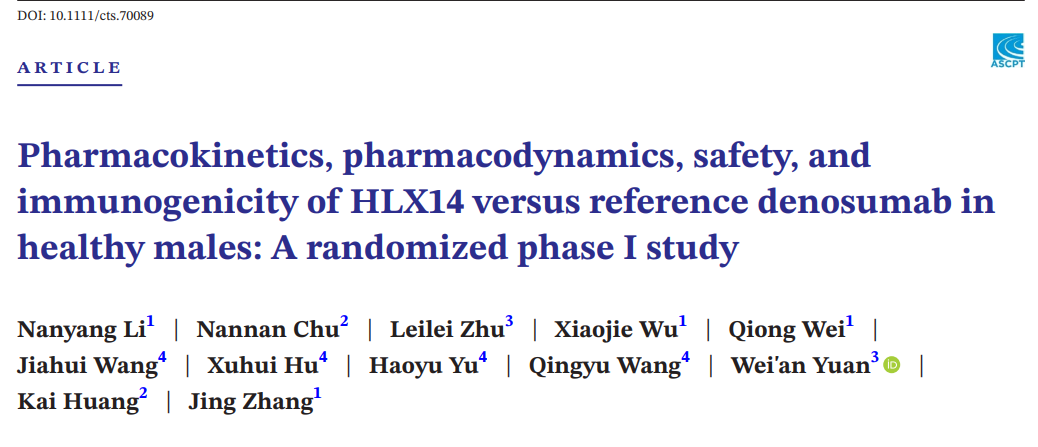Recently, results from the phase 1 clinical study (NCT04534582) of Henlius’ denosumab biosimilar candidate HLX14 (a recombinant anti-RANKL human monoclonal antibody injection) was published in Clinical and Translational Science (IF 3.1). The results of this study suggest that HLX14 had highly similar pharmacokinetic (PK) and pharmacodynamics (PD), as well as comparable safety, tolerability, and immunogenicity to the US-, EU-, and China-sourced reference denosumab (Prolia®). This study met all the pre-specified primary endpoints.

Henlius independently developed denosumab biosimilar candidate HLX14 in accordance with the NMPA, EMA, FDA, and other international biosimilar guidelines. In 2022, Henlius entered into a license and supply agreement with Organon for the exclusive commercialization rights to two biosimilar candidates, including HLX14. The agreement covers markets such as the United States, the European Union, and Canada. An exception from the agreement is China. In April 2024, the international multicenter phase 3 comparative clinical trial for HLX14 in postmenopausal women with osteoporosis at high risk for fracture met the primary endpoints. Based on a series of head-to-head comparison studies, the marketing applications of HLX14 have been accepted by the U.S. Food and Drug Administration (FDA), the European Medicines Agency (EMA), and Health Canada in 2024.
NCT04534582 is a two-part phase 1 clinical study in Chinese healthy adult male subjects. Part 1 is an open-label, randomised, parallel-controlled, single-dose, two-arm pilot study with the primary objective to compare the PK parameters of HLX14 and EU-sourced denosumab to provide further basis for the study design of part 2. The secondary objective of part 1 is to compare the PD, safety, tolerability, and immunogenicity of HLX14 and EU-sourced denosumab. Part 2 is a double-blind, randomised, parallel-controlled, single-dose, four-arm study with the primary objective to compare the PK similarity of HLX14 with US-, EU-, and China-sourced denosumab ("reference drug"). The secondary objective of Part 2 is to compare PD, safety, tolerability, and immunogenicity between HLX14 and the reference drugs. The primary study endpoints included AUC0–t, Cmax, and AUC0–inf.
The results of this study suggest that HLX14 is highly similar to the originator denosumab from different sources in PK and PD characteristics. In Part 2, in pairwise comparisons of HLX14 to the reference drugs, the resulting geometric mean ratios (GMRs) were all close to 1 for all three primary endpoints, and their 90% CIs all fell entirely within the pre-specified similarity margins of 0.80 to 1.25 (AUC0–t, 0.91–1.13; Cmax, 0.91–1.13; AUC0–inf, 0.91–1.12).
In terms of safety and tolerability, no new safety signal was identified in the HLX14 group as compared to the denosumab groups in the study, or to other denosumab biosimilars. Although all participants experienced treatment-related adverse events (TEAEs), most were grade 1–2.
HLX14 is expected to serve as an additional treatment option for patients worldwide and further enriches Henlius’ product portfolio in the global market. In the future, Henlius will continue to focus on clinical needs and provide more affordable and effective treatment options for patients worldwide.
